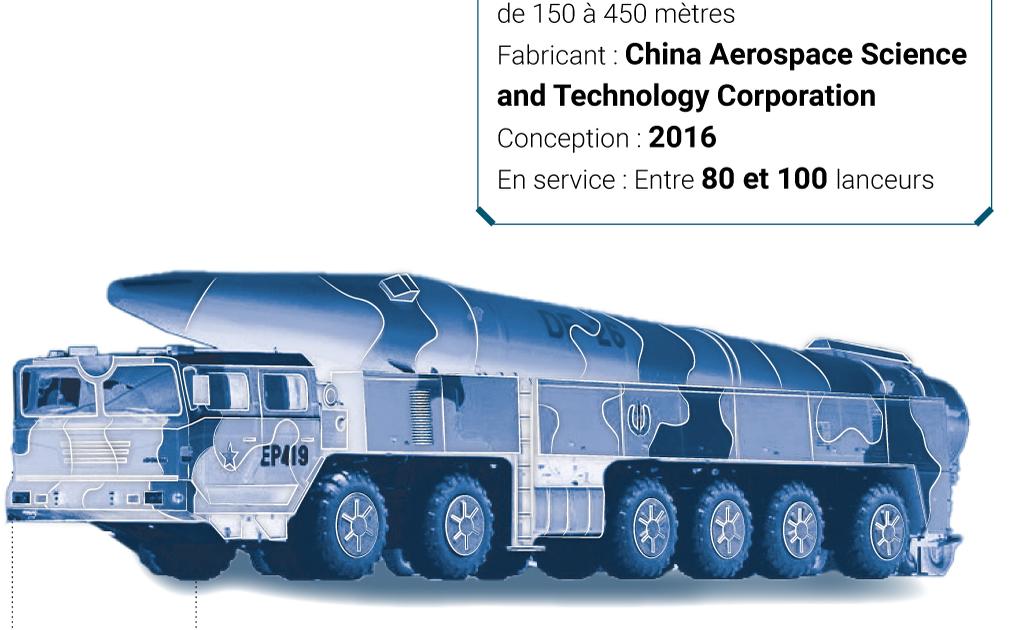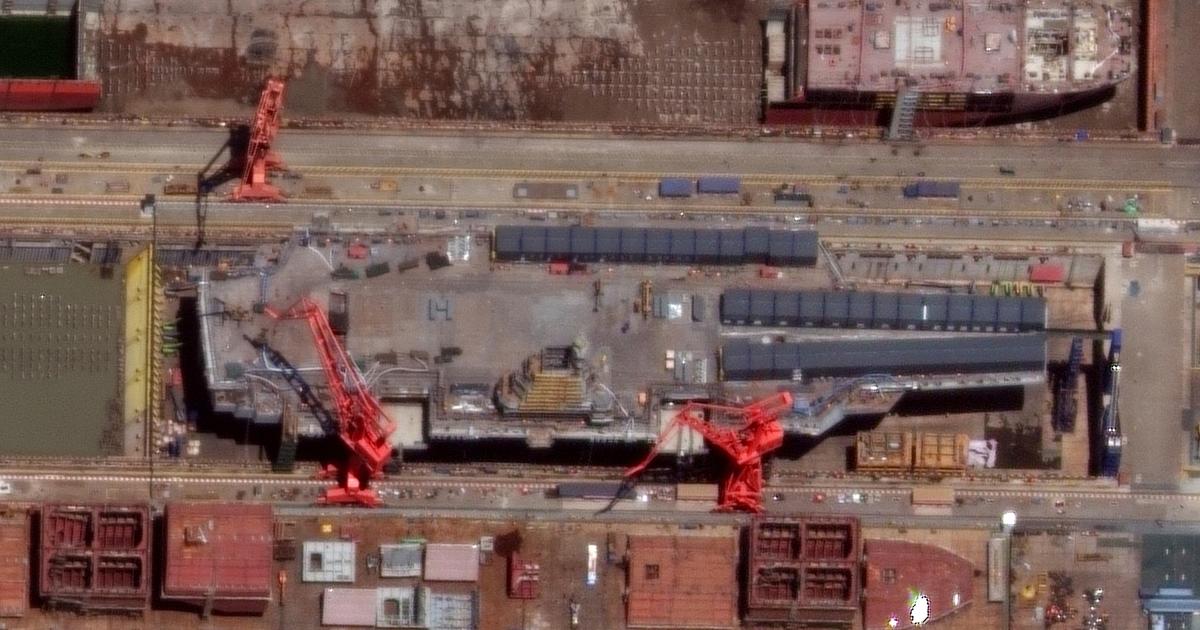The noose is tightening around Taiwan.
China, on April 8, even conducted a “
total encirclement
” exercise on the island.
Planes from Beijing enter Taiwanese airspace almost daily to test the resistance and nerves of Formosa.
Read alsoHas the Chinese army overtaken the Russian army?
To prevent, or punish, these inclinations, the Red Empire launched a major military reform in 2016, and considerably increased its production of armaments.
Admiral Vandier, chief of staff of the French Navy, estimated that the Chinese navy manufactures every four years the equivalent of the French fleet, adding that in "2030, the tonnage
of the Chinese navy will be [it ] 2.5 times that of the US Navy
”.
Nevertheless, the Chinese army has not had a fire experience since 1979, when it had to withdraw from Vietnam.
As
wargames
simulating a conflict multiply,
Le Figaro
reviews ten flagship weapons of China that could play a major role in the event of an invasion.
The J-20 stealth fighter jet
Touted as the new Chinese technological jewel, the J-20 is the first fighter
made in China
without a Russian engine.
It is a fighter aircraft which must in particular guarantee unrestricted access to enemy airspace.
"
It must conduct initial operations to capitalize on a strategic effect, such as the bombardment of enemy structures, its anti-aircraft capabilities or targets with very high added value
", describes Thibault Fouillet, research fellow at the Foundation for Strategic Research ( FRS).
This device is designed to fly over the front line and destroy enemy planes, preventing the reconstitution of a fleet that could hinder the conduct of Chinese operations.
Beijing would have about fifty copies.
Even if this very modern aircraft is a formidable weapon, technology without numbers, as the war in Ukraine shows, does not always bring superiority.
This observation applies to all the armaments described below.
The KJ-200 surveillance aircraft
Despite several accidents during its launch, the KJ-200 allows China to have a high-performance aerial surveillance aircraft, as well as a command post that can be installed there.
The only downside: “
the electronic equipment is not Chinese, but Swedish
”, underlines Léo Péria-Peigné, researcher at the Center for Security Studies of the French Institute for International Relations (IFRI).
Beijing, notwithstanding significant investments, has not yet caught up with this delay.
This aircraft is designed to fly a certain distance and provide intelligence to guide fighter squadrons.
Thus, if China invaded Taiwan and the United States came to their aid, the KJ-200 could be deployed to identify American buildings to be destroyed.
The GJ-11 UAV
This stealthy drone, a real treasure of technology, must compete with the American Reaper.
It can carry and fire hover bombs or precision air-to-ground missiles.
“
It has a very interesting cost-effectiveness ratio,
notes Thibault Fouillet
.
But the Chinese army is not the only one to have this type of machine.
Technological superiority will therefore not necessarily be acquired in the event of a conflict
”.
It nevertheless demonstrates a significant move upmarket in China.
Drones, however, require highly skilled personnel that Beijing may lack.
“
This technology therefore remains more embryonic than the Chinese army wants to say
,” tempers Léo Péria-Peigné.
Advantage: GJ-11s can take off from a helicopter carrier.
A military source underlines "
the very great opacity of the Chinese on a device which could, in large quantities, inflict severe damage on the American fleet
".
The DF-26 ballistic missile
This intermediate-range ballistic missile, which can reach targets 5,000 kilometers away, is also "
a technological asset from China
", notes Thibault Fouillet.
It could therefore hit the American base in Guam, located nearly 3,000 kilometers away.
"
The Americans can no doubt intercept it now
", nuance Philippe Gros, senior researcher at the FRS.
"
The acquisition of long-range missiles was a question that punctuated the Cold War
", recalls Léo Péria-Peigné.
Beyond a very hypothetical strike on an American base, the DF-26 could above all keep American aircraft carriers at a distance because it also has an anti-ship capability.
The S-300 anti-missile system
This formidable Russian system, present in Ukraine, can target up to 24 aircraft at the same time and, depending on the version, intercept a target over a distance of more than 250 kilometers.
As a reminder, the closest distance between Taiwan and the mainland is 130 kilometers.
"
This system could be used to create protective bubbles
," says Léo Péria-Peigné.
However, this very heavy system is difficult to transport.
“
It would serve more to cover the departure and concentration areas of troops
” than to secure a bridgehead in Taiwan, thinks Léo Péria-Peigné.
Beijing has also developed its own system derived from the Russian missile, the HQ-9, and has purchased S-400s, the modernized version of the S-300, from Moscow.
Fujian
aircraft carrier
The latest addition to the Chinese navy, the aircraft carrier
Fujian
has an electromagnetic catapult, which until now only the United States had.
Nevertheless, it remains a conventional aircraft carrier, without nuclear propulsion, and must therefore be refueled regularly.
"
The
Foch
had to be on average every three days
", underlines Léo Péria-Peigné.
And electromagnetic propulsion is particularly energy-intensive.
"
In my opinion, these ships, in a conflict over Taiwan, do not bring much against Taiwan itself (no need for naval aviation on board so close to the Chinese coast) and in the operations of interdiction of the Americans, they would represent interesting targets for the US
Navy, in particular for its nuclear submarines or its own naval aviation, and for the Air Force
”, insists Philippe Gros.
On the other hand, Beijing has commissioned three type 075 helicopter carriers in 2021 and 2022. Particularly massive, they would play a decisive role in the invasion of the island.
The Type 055 destroyer
This destroyer, a ship capable of defending a group of buildings, has 112 cells of vertical launch systems (VLS), a record number.
In comparison, the French anti-aircraft defense frigates (FDA) have only 48. Its weight is also substantial: 12,000 tons against 7,000 for the French.
China has managed to put eight of them into service in just four years, a symbol of the dynamism of its maritime construction.
But this building, like the aircraft carrier, "
requires qualified crew which is a rare resource for China
", underlines Léo Péria-Peigné.
The ZTZ-96 main battle tank
"
All these tanks come from the Soviet T64
", immediately specifies Marc Chassillan, international consultant and defense industry expert.
Some original parts have been sinicized like the engine, the gearbox and part of the fire control.
Taiwanese terrain is not conducive to tank combat.
"
Either they wade through the rice fields, or they fight in town...
", remarks Marc Chasillan.
The tanks will therefore not be able to be used decisively because of this partitioning of the terrain.
The Taiwanese, equipped with American M1 Abrams "
which has superior performance on paper, will not necessarily have a decisive advantage
", adds Marc Chassillan for whom the advantage of the tank will go to the one who "
masters the tactics, uses the best the ground or will know how to camouflage itself
".
The 63A amphibious light tank
This tank, a copy of the Russian PT 76 which equipped the Russian marine troops, can “
be dropped 1,500 or 2,000 meters from the coast,
specifies Marc Chassillan
.
It can shoot while in water, but has weak armour
.
For Beijing, the interest of this material, in the process of being replaced, would be above all to saturate the Taiwanese defenses by dispatching hundreds of armored vehicles to the beaches, thus multiplying the targets, but also the probability that they arrive on the beach.
"
The 63-A could be used to support a landing
", notes Léo Péria-Peigné for whom these materials resemble the French AMX-10 RC armored reconnaissance vehicles.
The Type 89 armored vehicle
This tracked machine, also amphibious, is equipped with a 12.7 mm machine gun, but has little armor.
“
It's not a machine at the top of technology,
ironically Marc Chassillan.
But it is a brave troop transport vehicle
”.
Seven soldiers can ride there in addition to the three crewmen.
This vehicle could also be used to "
shuttle with ships to supply a bridgehead
", adds Marc Chassillan.
More generally, an amphibious landing requires significant combined arms coordination.
“
You have to master the three dimensions: sea to cross and supply the bridgehead, air to protect the landing and land, because expanding a bridgehead is a complex operation.
In Normandy, the Allies had taken a long time to advance in the Normandy bocage
,” recalls Thibault Fouillet.
For Taiwan, it will be essential to gain time and to sufficiently retain the Chinese troops while awaiting the arrival of the Americans.






